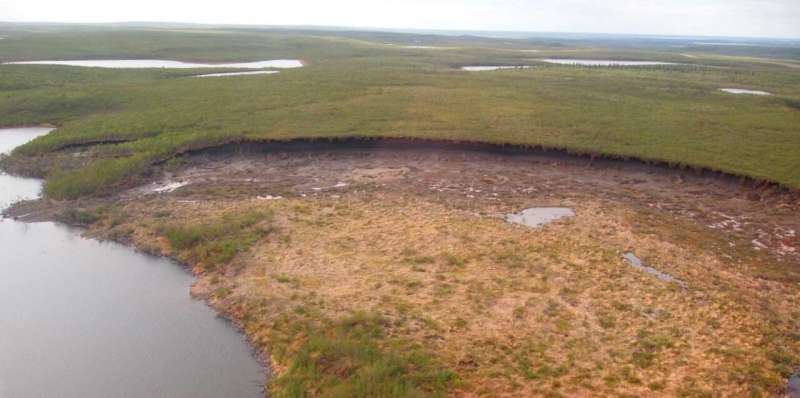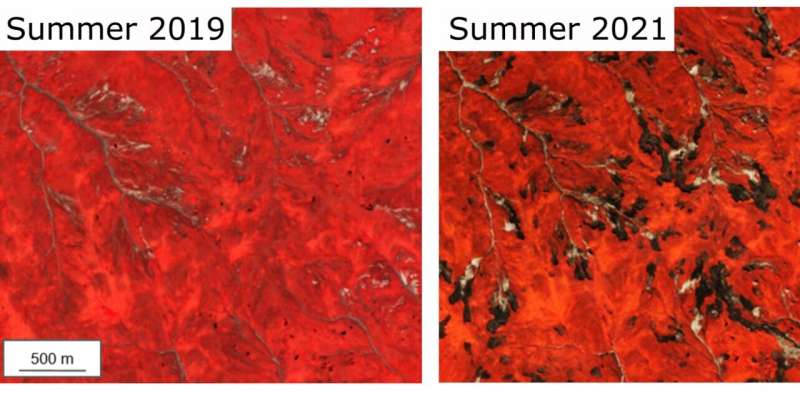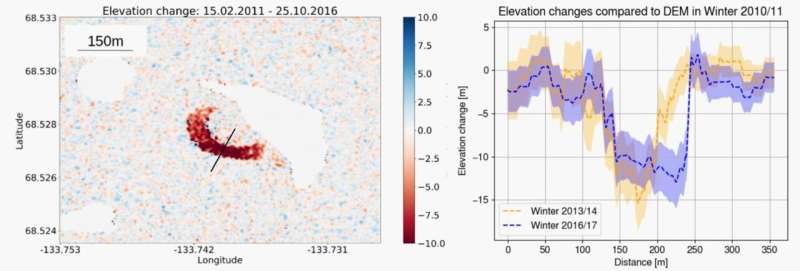Heat waves thawing Arctic permafrost

In the northernmost region of the earth the arctic permafrost is melting at an accelerated rate. For more than a decade, an international team of researchers from ETH Zurich, the University of Alaska Fairbanks, and the German Aerospace Center have observed topographical pock marks—large depressions referred to as, "retrogressive thaw slumps." The slumps occur when permanently frozen layers of soil (ice-rich permafrost) melt leaving arctic hillslopes vulnerable to landslides. The landslides signal a risk for the potential release of carbon that has been stored in the permafrost for tens of thousands of years.
Risk for release of organic carbon
Their findings, recently published in the European Geosciences Union journal The Cryosphere, reveal substantial changes to the topography of Siberia's Taymyr peninsula, in northern Russia. The study's results reveal a strong, 43-fold increase in retrogressive thaw slump activity and a 28-fold increase in carbon mobilization. The increase also happens to coincide with an extreme heat wave that occurred in northern Siberia in 2020 in which temperatures reportedly reached 38 degrees Celsius (more than 100 degrees Fahrenheit)—record-breaking temperatures for the Arctic region.
"The strong increase in thaw slump activity due to the Siberian heatwave shows that carbon mobilization from permafrost soils can respond sharply and non-linearly to increasing temperatures," asserts the paper's lead author, Philipp Bernhard, Institute of Environmental Engineering, ETH Zurich.
Measuring changes to Arctic permafrost
Using satellite data, the research team has been able to develop a new method to quantify carbon mobilization in permafrost soil. Currently no other large-scale method exists that measures, to such a high level of spatial and vertical resolution, the changes in permafrost regions. This method allows researchers to provide a more accurate estimate of the state of the carbon cycle to the global carbon budget.
Building on an earlier field and airborne flight study conducted in Canada's Mackenzie River Delta, the researchers collected pre-study data that they later used to compare and analyze with satellite acquired data over the same region. Since 2010, the German Aerospace Center has been operating an innovative satellite mission using single-pass synthetic aperture radar, the TanDEM-X mission, to collect 3-dimensional elevation data over the earth surface. In addition to the radar data, from 2015, researchers analyzed data obtained from the optical Sentinel-2 satellites deployed as part of the European Space Agency's Earth Observation mission, Copernicus Program with the focus on the arctic landscape.

Neglected part of Arctic carbon cycle
Siberia's Taymyr peninsula, like many areas of the arctic, is a remote and nearly inaccessible region making scientific field studies a challenging, if not impossible, operation. The findings of this study indicate; however, that summer heatwaves and warming arctic regions pose a significant environmental risk that are worth monitoring.

The Arctic permafrost reportedly encases approximately 1.5 trillion metric tons of organic carbon, about twice as much as currently contained in the atmosphere. Bernhard agrees that the potential risks associated with this type of carbon mobilization is "a major, but largely neglected component of the Arctic carbon cycle." The research team anticipates that satellite remote sensing will be an indispensable tool for continuous monitoring of carbon mobilization resulting from melting permafrost across the Arctic.
More information: Philipp Bernhard et al, Accelerated mobilization of organic carbon from retrogressive thaw slumps on the northern Taymyr Peninsula, The Cryosphere (2022). DOI: 10.5194/tc-16-2819-2022
Philipp Bernhard et al, Mapping Retrogressive Thaw Slumps Using Single-Pass TanDEM-X Observations, IEEE Journal of Selected Topics in Applied Earth Observations and Remote Sensing (2020). DOI: 10.1109/JSTARS.2020.3000648
Journal information: The Cryosphere
Provided by ETH Zurich




















